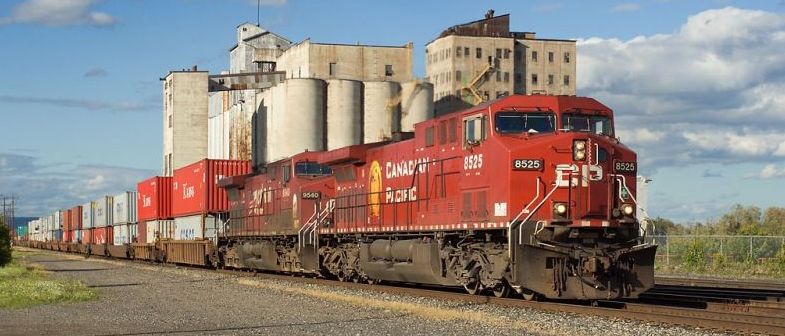
Train Addiction Help Line: 1.866.840.7777
Apr 6, 2017 - Periodical News
Special K+S Potash Canada Commemorative Car - for Immediate Release
Dear Customers: Special Announcement (Update)
Dear HO Scale Modelers: We have just received our first pre-production paint sample of the new K+S car. It has been approved.
The cars are on track to be here early June, most of the cars will be made for K+S for publicity reasons. (they will be given away to invited guests to the grand opening of their new multi million dollare facility in BC in June 2017.
We have been given permission to make a few extra for our customers. Since production numbers are already set (they can't be increased) if you want a really special car, make sure you order one. About 30 cars are left out of 300.
Remember if its good enough for K+S and NSC its probably accurate enough for modelers.
Stay tuned for many other announcements in the next few weeks.

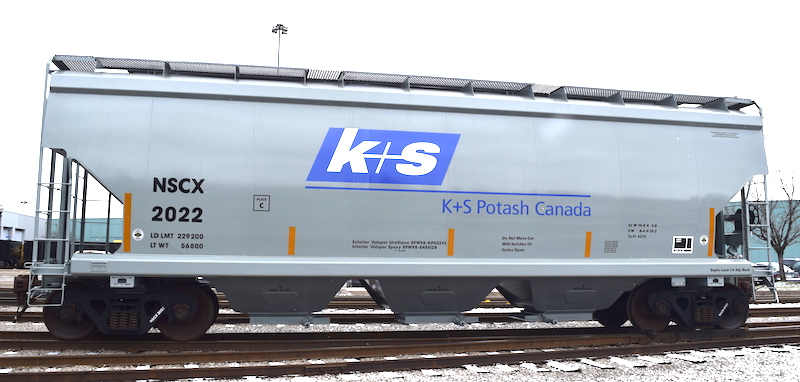
As many of you are aware, in Canada there are three major producers of Potash: Agrium, Mosaic, and Sask Potash.
The three companies own Canpotex, to market and ship potash around the world.
Well there is a new kid on the block. A European Company called K+S through its Canadian subsidury K+S Potash Canada has been quietly setting up production in Canada. Their giant new "Legacy Mine" near Moose Jaw will starting shipping potash in the second quarter 2017.
We were contacted by K+S last week. All of the potash for export oversea's will be shipped from their new facility located in Port Moody BC by Pacific Coast Terminals. (See Image below) Just a quick FYI - this is also one of two places in Vancouver where SULTRAN sends sulphur to loaded onto ships.
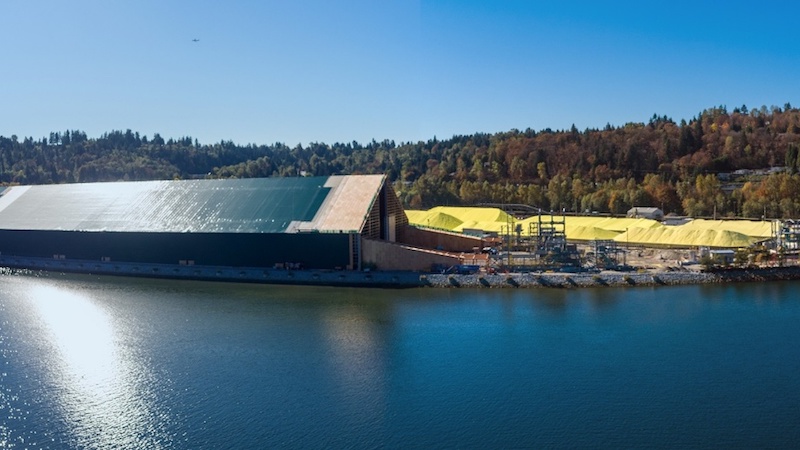
Last year National Steel Car painted up a single car for K+S and this is the car we will be making to commemorate the event.
K+S and NSC have asked us if we can rush into production copies of this car, so they can give copies of the car away to the invited dignitaries at the event in June. The car is structurally the same version as last years CEFX car with 8 body panels and notched gap between the hopper bays.
Since our factory in China is about to start production on our next batch of Potash cars, we will try and squeeze this car in first.
We are sorry we can't give you much time to decide if you want one of these commemorative cars, we have to give numbers to our factory in China in a few days. K+S and NSC will be taking the entire run, if you want one get your order in as quick as you can.
One other question you may have is K+S going to be building additional cars with NSC? Because of confidentiality we can't comment at this time, but you can read between the lines.
Below we will attach information about the company and the project.
About the K+S Group
K+S Potash Canada GP is part of the K+S Group, an international resources company. We have been mining and processing mineral raw materials for more than 125 years. The products we produce from them are used worldwide in agriculture, food and road safety and are important elements in numerous industrial processes. Potash and salt are integral nutrients for the megatrend of a constantly growing and increasingly prosperous global population striving for a higher standard of living. This will result in increasing consumption of mineral resources. We serve the resulting growth in demand from production sites in Europe, North America and South America as well as through a global distribution network. K+S is the world’s largest salt producer and one of the top potash providers worldwide. With more than 14,000 employees, K+S achieved revenues in financial year 2015 of about € 4.2 billion and an EBIT of € 782 million.
About K+S Potash Canada GP
K+S is putting its world-class expertise to work on the Legacy Project, the first new greenfield potash mine built in Saskatchewan in over forty years. The potash solution mine and production facility is being built near Moose Jaw, Saskatchewan, where commissioning of the plant facilities officially began in August 2016. Work to repair a damaged process vessel has progressed according to schedule, production of the first tonne of potash is currently projected for the second quarter of 2017, and. K+S is still anticipating that it will achieve its target production capacity of two million tonnes by the end of 2017.
In addition to the mine site, the Legacy Project has also partnered with Pacific Coast Terminals (PCT) and Canadian Pacific (CP) for port and rail initiatives. In spring of 2014, PCT and KSPC signed an exclusive, long-term agreement that called for the construction of a new potash handling and storage facility at PCT’s bulk handling facility located in Port Moody near Vancouver, British Columbia. Potash bound for port will be transported by CP from the Legacy Project mine site.
Once the Legacy Project is completed, K+S Group will strengthen its global presence through:
- Expanding its current production portfolio in Germany with a North American production site
- Securing a good asset base with competitive production costs
- Sales and distribution through existing
distribution structures of the K+S group - Exclusive outline agreement with Koch Fertilizer about supply and sales of Potash fertilizers in the US
- Regional growth projects in China and
Southeast Asia - Flexible multi-product strategy
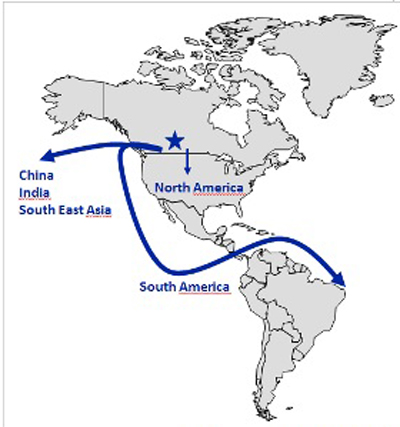
KSPC is contributing to Saskatchewan and British Columbia’s economic growth through employment, tax revenues, utilities, royalties and local partnerships.
Employment Figures
KSPC directly employs a total of 397 permanent employees across our headquarters in Saskatoon, corporate office in Vancouver, BC, and the Legacy mine site. The target permanent KSPC workforce is approximately 435 people.
The daily construction workforce for the Legacy Project is currently about 1,700. However, with approximately 1/3 of the workforce off on turnaround at any given time, the overall workforce is approximately 2,400.The total number of people that have been employed to date by the Legacy Project is calculated by the number of full site orientations completed, which is approximately 22,500.
KSPC is also committed to employing a representative workforce. To date, more than $350 million in contracts have been awarded to various local indigenous communities, entrepreneurs and partnered companies. Over 344 First Nations or Métis have been employed through our contractors on the Legacy Project site while 8% of our direct employees self-identify as First Nations or Métis.
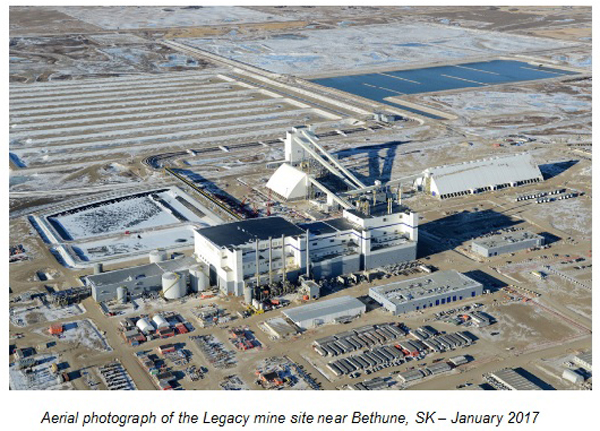
Project Overview
K+S is putting its more than one hundred years of mining experience and world-class expertise to work on the Legacy Project.


The Legacy Project potash mine and production facility is the first new greenfield potash mine built in Saskatchewan in nearly forty years, located in the RM of Dufferin #190, near the communities of Bethune and Findlater.
Together with our Design and Project Management partner Amec Foster Wheeler, K+S Potash Canada (KSPC) is currently in the process of constructing the Legacy Project mine site. Commissioning is targeted for the summer of 2016, and K+S projects to reach the two-million-tonnes-mark of production capacity at the new location at the end of 2017.
The Legacy Project will mean new job opportunities for Saskatchewan workers, and new business opportunities for Saskatchewan companies supplying goods and services to this major economic development. It will also contribute to Saskatchewan’s growth through employment, tax revenues, utilities and local partnerships.
The construction of the mine will make K+S the only potash producer with production sites on two continents, extending the worldwide presence of K+S Group and increasing its average mine life.
Port and Rail
In addition to the mine site, the Legacy Project also includes Rail and Port initiatives.
K+S Potash Canada (KSPC) has partnered with Pacific Coast Terminals (PCT) for the port initiative. In spring of 2014, PCT and KSPC signed an exclusive, long-term agreement that called for the construction of a new potash handling and storage facility at PCT’s bulk handling facility located in Port Moody near Vancouver, British Columbia. Potash products arriving by rail from the Legacy mine will be stored on site and transported to vessels destined for K+S Group’s international clients. Construction for the modifications of this facility are currently underway.
To ensure a rail connection, KSPC partnered with Canadian Pacific (CP). Potash bound for port will transported by CP from the Legacy Project mine site. CP is currently in the process of constructing a 30 km Belle Plaine Spur line linking the Legacy site to existing CP track near Belle Plaine. KSPC will construct a 14 km line that links this spur to a loop at the potash mine’s loading facilities and will build about 6 km of storage track adjacent to its line. Learn more about the CP Belle Plaine Spur Project.


Community and Economic Benefits
K+S Potash Canada is committed to contributing to Saskatchewan’s economic growth, being an active part of the community and being a responsible neighbour.

Economic Growth Impacts
Some of the many economic benefits and opportunities of the Legacy Project include:
- Increased employment, labour income, tax base and population of surrounding communities
- New tax revenues from the project at all levels of government (local, provincial and national)
- A construction workforce peaking at around 1,800 in 2015; approximately 300 permanent jobs when in production in 2017
- New business opportunities for Saskatchewan companies supplying goods and services to a major industrial development
Community Engagement
Engaging and involving people who could be or are affected by the Legacy Project is an important part of our business. Since the initial phases of the Legacy Project, building meaningful relationships continues to be a focus.
Examples include:
- The general public (e.g. local communities, communities of interest, landowners, and residents);
- First Nations and Métis communities.
Engagement activities were initiated in the second quarter of 2008, and are expected to continue throughout the Legacy Project’s life. Engagement activities include presentations, community information sessions, group meetings, one-on-one meetings, site visits, supplier development forums and collaboration on contracts and employment with First Nations and Métis communities and individuals.
Sustainability
K+S takes the long view on any project, in the interest of protecting both people and the environment.
K+S Potash Canada strives to develop our projects and conduct operations according to the foundational principle that the requirements of economic success, scheduling and development must always be in balance with the prerequisites of health, safety, and the environment. We consider the full lifecycle of our projects when developing facilities, with the goal of sustainable, future oriented development, protecting local biodiversity and proactively managing health, safety and environmental outcomes for the benefit of all stakeholders and the community at large. We seek to do this by identifying and assessing potential interactions of our business with people and the environment, applying appropriate mitigation measures, and actively monitoring and managing our operations at all stages. We also strive to continually improve our processes over time.

What is Solution Mining?
Solution mining is the process of mining underground water-soluble minerals by dissolving the minerals with water. The mineral-rich solution (called brine) is then extracted from the ground and the minerals are recovered from it.
For each cavern, two boreholes are directionally-drilled from a pad at the surface so that the wells are spaced about 80m apart at a depth of 1,500m. For the development process, a casing is inserted into each well to enable circulation of water and dissolve minerals first as a sump and finally connect the wells into a single cavern.
At this point, the production process can begin. Hot water is continuously pumped down one well, where it continues to dissolve the minerals into sodium chloride and potassium chloride-rich brine, which is pushed up the second well to the surface.
Once on the surface, the brine is processed at our facility. Using the differences in solubility for sodium and potassium chloride, the brine is concentrated and salt and potash subsequently crystallized through evaporation and vacuum cooling crystallization. The final products are finished in the dry plant, before they go to storage and train loading. As the solution mining process is water-and-energy-intensive, great efforts have been taken to conserve and re-use as much of the natural resources as possible.



